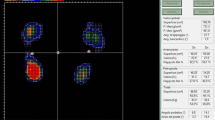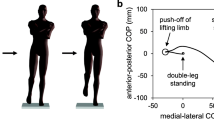Abstract
Introduction
Due to the controversial information about postural stability in patients with lower limb joints osteoarthritis (OA), the following main questions are raised: how serious is the postural stability disturbance and which factors have an impact on postural stability before and after total knee arthroplasty (TKA).
Materials and methods
Force plate was used to assess postural stability and custom-made dynamometer was used to assess isometric maximal voluntary contraction (MVC) force of leg extensor muscles; besides, knee pain and knee range of motion (ROM) was evaluated in 14 female patients (aged 46–68 years) with knee OA 1 day before, and 3 and 6 months following TKA and once in healthy controls (aged 48–70). Relationship between postural stability during standing and selected anthropometric and functional characteristics were investigated with Spearman’s correlation coefficients.
Results
Remarkable reduction of knee pain and improvement in active ROM for the operated leg were shown after unilateral TKA. MVC force of leg extensor muscles achieved the preoperative level half a year after TKA. The centre of pressure (COP) of sway displacement in anterioposterior (AP) and mediolateral direction and the equivalent area of COP sway for the operated leg did not differ before, 3 and 6 months after TKA and compared to the non-operated leg. The trace speed was 6 months after TKA equal to the preoperative level. Only the COP of sway displacement in AP direction is significantly greater in knee OA patients both before and after TKA compared with healthy controls.
Conclusions
Knee OA patients’ postural stability characteristics did not differ significantly both before and after TKA. Compared to healthy controls, the COP of sway displacement in AP direction is mostly disturbed. Correlation analysis confirms that increased postural sway is associated with an increased equivalent area of COP. In knee OA patients higher body mass index ensures reduced trace speed and lower knee ROM.
Level of evidence
Prospective comparative study, Level II.


Similar content being viewed by others
References
Hassan BS, Mockett S, Doherty M (2001) Static postural sway, proprioception, and maximal voluntary quadriceps contraction in patients with knee osteoarthritis and normal control subjects. Ann Rheum Dis 60:612–618
Hinman RS, Bennell KL, Metcalf BR, Crossley KM (2002) Balance impairments in individuals with symptomatic knee osteoarthritis: a comparison with matched controls using clinical tests. Rheumatology 41:1388–1394
Hurley MV, Scott DV, Rees J, Newham DL (1997) Sensimotor changes and functional performance in patients with knee osteoarthritis. Ann Rheum Dis 56:641–648
Masui T, Hasegawa Y, Yamaguchi J, Kanoh T, Ishiguro N, Suzuki S (2006) Increasing postural sway in rural-community-dwelling elderly persons with knee osteoarthritis. J Orthop Sci 11:353–358
Schwartz I, Kandel L, Sajina A, Litinezki D, Herman, Matta Y (2012) Balance is an important factor for quality of life and function after primary total knee replacement. J Bone Joint Surg Br 94-B:782–786
Lyytinen T, Liivakaino T, Bragge T, Hakkarainen M, Jarjalainen PA, Arokoski JPA (2010) Postural control and thigh muscle activity in men with knee osteoarthritis. J Electromyogr Kinesiol 20:1066–1074
Swanik CB, Lephart SM, Rubash HE (2004) Proprioception, kinesthesia, and balance after total knee arthroplasty with cruciate-retaining and posterior stabilized prosthesis. J Bone Joint Surg 86-A:328–334
Arokoski JPA, Leinonen V, Arokoski MH, Aalto H, Valtonen H (2006) Postural control in male patients with hip osteoarthritis. Gait Posture 23:45–50
Cho SD, Hwang CH (2012) Improved single-limb balance after total knee arthroplasty. Knee Surg Sports Traumatol Arthrosc. doi:10.1007/s00167-012-2144-x
Hunt MO, McManus FJ, Hinman RS, Bennell KL (2010) Predictors of single-leg standing in individuals with medial knee osteoarthritis. Arthritis Care Res 62:496–500
Chiari L, Rocchi L, Cappello A (2002) Stabilometric parameters are affected by anthropometry and foot placement. Clin Biomech 17:666–677
Argatov I (2013) A subject-specific postural instability parameter. Gait Posture 37:141–143
Roddy E, Zhang W, Doherty M et al (2005) Evidence-based recommendations for the role of exercise in the management of osteoarthritis of the hip or knee—the MOVE consensus. Rheumatology 44:67–73
Lin DH, Lin YF, Chai HM, Han YC, Jan MH (2007) Comparison of proprioceptive functions between computerized proprioception facilitation exercise and closed kinetic chain exercise in patients with knee osteoarthritis. Clin Rheumatol 26:520–528
Hurley MV (2003) Muscle dysfunction and effective rehabilitation of knee osteoarthritis: what we know and what we need to find out. Arthritis Care Res 49:444–452
Hart DJ, Doyle DV, Spector TD (1999) Incidence and risk factors for radiographic knee osteoarthritis in middle-aged women. Arthritis Rheumatol 14:17–24
Slemenda C, Heilman DK, Brandt KD, Katz BP, Mazzuca SA, Braunstein EM, Byrd D (1998) Reduced quadriceps strength relative to body weight: a risk factor for knee osteoarthritis in women? Arthritis Rheumatol 11:1951–1959
Doyle TL, Newton RU, Burnett AF (2005) Reliability of traditional and fractal dimension measures of quiet stance centre of pressure in young, healthy people. Arch Phys Med Rehabil 86:2034–2040
Salavati M, Hadian MR, Mazaheri M, Negahban H, Ebrahimi I, Talebian S, Jafari AH, Sanjari MA, Sohani SM, Parnianpour M (2009) Test-retest reliability of center of pressure measures of postural stability during quiet standing in a group with musculoskeletal disorders consisting of low back pain, anterior cruciate ligament injury and functional ankle instability. Gait Posture 29:460–464
Menegoni F, Galli M, Tacchini E, Vismara L, Cavigioli M, Capodaglio P (2009) Gender-specific effect of obesity on balance. Obesity 17:1951–1956
Britton AR, Murray DW, Bulstrode CJ, McPherson K, Denham RA (1997) Pain levels after total hip replacement. J Bone Joint Surg 79-B:93–98
Hue OA, Seynnes O, Ledrole D, Colson SS, Bernard P-L (2004) Effects of a physical activity program on postural stability in older people. Aging Clin Exp Res 16:1–7
Gauchard GC, Vancon G, Meyer P, Mainard D, Perrin PP (2010) On the role of knee joint in balance control and postural strategies: effect of total knee replacement in elderly subjects with knee osteoarthritis. Gait Posture 32:155–160
Greve J, Alonso A, Bordini ACPG, Camanho GL (2007) Correlation between body mass index and postural balance. Clin Sci 6:717–720
Horak FB (2006) Postural orientation and equilibrium: what do we need to know about neural control of balance to prevent falls? Age Ageing 35(S2):7–11
Acknowledgments
The authors are very grateful to Professor Tiit Haviko, Dr. Aare Märtson and physiotherapist Galina Schneider for their contribution to subject’s operative treatment and postoperative rehabilitation. We are also indebted to Herje Aibast and Monika Rätsepsoo for their assistance with data collection. We acknowledge that this study was partly supported by the Estonian Ministry of Education and Research project No. SF0180030s07 and Estonian Science Foundation project No 7939.
Conflict of interest
The authors confirm that there are no potential conflicts of interest including any personal or other relationships with other people or organizations associated with the work submitted that could inappropriately influence their work.
Author information
Authors and Affiliations
Corresponding author
Rights and permissions
About this article
Cite this article
Vahtrik, D., Ereline, J., Gapeyeva, H. et al. Postural stability in relation to anthropometric and functional characteristics in women with knee osteoarthritis following total knee arthroplasty. Arch Orthop Trauma Surg 134, 685–692 (2014). https://doi.org/10.1007/s00402-014-1940-9
Received:
Published:
Issue Date:
DOI: https://doi.org/10.1007/s00402-014-1940-9




